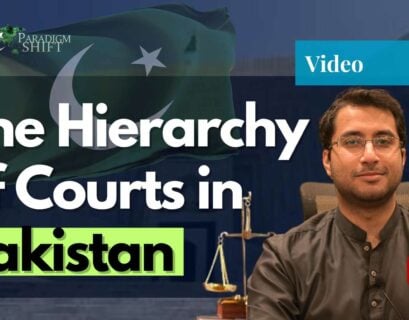Introduction
As Pervaiz Elahi was finally sworn in as Chief Minister of Punjab in the late hours of 27th July, another episode of Pakistan’s political fiasco came to a close, but not without the foreshadowing of much more thrilling arcs in the future. What went on in Punjab can be seen through the lens of an inter-dynastic political crisis or a legal conflict in the Supreme Court on Article 63A rooted in the unstable balance of power between our state institutions. In reality, it is both of these and much more.
The Punjab conundrum, as I shall analyze below, embodies the utterly dysfunctional nature of our political system; one which is dominated by an intra-elite merry-go-round which sways in one direction and then the other, all providing an increasingly dirty fuel to a status-quo wherein the concerns of ordinary people are subjugated to the decadent whimsies of the elite class.
As It Happened
It was only around four months back when the parliament passed the no-confidence motion against then Prime Minister Imran Khan. The events of April proved to be one of tumult and suspense, with the skipper conjuring up every trick up his sleeve to prevent the inevitable, culminating in his infamous narrative of there being a foreign conspiracy poised to dethrone him.
The narrative re-energized Khan’s social base, which had gone quiet in the twilight of his increasingly unpopular and badly governed prime ministership. Eventually, the National Assembly speaker refused to start the vote on the basis of these allegations, creating an impasse which was resolved only through the intervention of the Supreme Court.
The Supreme Court, after some deliberation, ordered for the vote to go along as scheduled, and so the PTI’s rule crumbled, but not without a bang which reverberated far into the forthcoming political instability. Then, we enter Punjab, where the resignation of Usman Buzdar led to another vacuum which the opposition wished to capitalize upon.
The election of Hamza Shahbaz as Chief Minister felt an inevitability ensured by the defection of 20 PTI MPAs who believed they were jumping off a sinking ship. The possibility of defection, however, had already prompted PTI to submit a presidential reference on how defectors would be dealt with as per Article 63A of the constitution.
Legal experts agreed that the law could not be translated into the discounting of the defectors’ votes but only their de-seatment following the deliberations of presiding officers. The Supreme Court order of 17th May, then, on the interpretation of Article 63A came as a shock to many. In a 3 to 2 decision, it was decided that the votes of defectors would be discounted in line with their de-seatment.
For the two dissenting judges, this decision amounted not to an interpretation of the constitution but a re-writing of it, setting dangerous precedents for parliamentary politics by providing arbitrary control to parliamentary party heads over party direction. With the PTI MPAs de-seated, the Punjab by-elections were held to fill in the vacuum.
The Punjab by-elections led to a resounding PTI victory with political analysts all over the country scrambling to provide an explanation for why PML-N lost control over its political heartland. Some pointed to the potency of Khan’s foreign conspiracy narrative, noting how it struck a chord with a social base tired of its historical subjugation towards imperialist powers.
Others, however, evaluated that the Insafians won in spite of Imran Khan’s conspiratorial tone, rather than because of it. For them, it was a mix of the PML-N having to suffer the brunt of making unpopular economic reforms in the center while handing out tickets to dissenters rather than loyalists in the province. Whatever the reason may be, the ultimate victory of the PTI put Hamza Shahbaz’s CM-ship dreams into serious jeopardy.
The Final Card
The 22nd of July was anticipated as the day when PTI regained control over the political stronghold of the country. Very few saw this process occurring peacefully, but a vast majority saw it as a given, and while PTI did finally get control over Punjab through Pervaiz Elahi on the 28th, the six days before that marked another episode of black comedy in our parliament.
The Supreme Court was warned by senior judges of the dangerous precedent it had set with its re-writing of Article 63A, but this warning manifested into reality only two months after that verdict. For the third time in only four months, the legislature and executive were paralyzed by a parliamentary stand-still, only to be resolved by judicial intercession.
To provide some context, the PTI required the ten votes of a small dynastic party known as the PML-Q in order to secure Punjab. In return, the parliamentary chief of the party, Chaudhry Pervaiz Elahi, was to be sworn in as Chief Minister. In the dying embers of its rule, the PDM coalition used the final weapon in its arsenal, convincing Chaudhry Shujaat, the party head of PML-Q to invoke 63A and de-seat all ten members of the party for not following the directives of the party head.
The president of the People’s Party, Asif Ali Zardari, played the decisive role in this invigorating new twist, and the CM vote was delayed once again following a ruling by Deputy Speaker Dost Mazari. Led by Elahi, the PTI and PMLQ filed a petition to the Supreme Court against this ruling. The court decided on a three-member bench led by CJP Umar Ata Bandial to resolve this looming parliamentary standstill.
With the petition for a full-bench hearing to interpret Article 63A rejected by the Supreme Court, the PDM boycotted the Supreme Court hearing, arguing that a crisis of this magnitude can be resolved only through an extensive review of 63A by a full court. Analysts such as Zahid Hussain have argued that such a demand was not misplaced, since the ruling on 63A has been riddled with all sorts of legal entanglements and inconsistent precedents.
In any case, the Supreme Court bench declared the Speaker’s ruling as not being binding owing to the erroneous implementation of Article 63A. The fiasco ended with Pervaiz Elahi sworn in as Chief Minister, marking the end of Hamza Shahbaz’s imperceptibly short stint.
Inter-Institutional Conflict?
In a political scene so polarized that it is almost entirely dependent on judicial intercessions on resolving standstills, judgements will always lead to cries of institutional partisanship. That was exactly what happened in April with PTI and now with the opposition. Both termed the decisions taken against their interests as ‘judicial coups’ and those in favor were seen as embodying the essence of their commitment to impartiality.
The rules of the game have become such that all political parties have historically sought—or have been subjugated to—the arbitration of non-representative institutions. In a country where an elected prime minister has himself admitted to having his rule obstructed by non-democratic institutions which helped propel him into power, questions of a lack of institutional legitimacy of the parliament sow seeds of political disillusionment within a disgruntled public.
In this particular case, the space historically given to the judiciary to resolve issues and provide political cohesion has created a situation mutually detrimental to the legitimacy of both institutions. Firstly, I have analyzed above how Article 63A was re-interpreted in a short order notice which has been criticized by legal experts as being an overreach in the judiciary’s role. Senior judges such as Faez Isa also criticized the lack of selection of senior judges and the inclusion of a larger bench to interpret and review the law.
Furthermore, the extremely short notice provided in declaring Mazari’s ruling as null and void has provided further evidence that in arbitrating immediate sensitive political impasses, the Supreme Court sacrificed the judicial process, creating dangerous precedents in the process. Legal experts such as Reema Omer have questioned why the 18th amendment judgment in 2015 by Azmat Saeed, wherein 8 (or as she argues, 9) out of 17 judges explicitly supported the right of the party head to issue directions regarding the vote of confidence, is not binding on the three-bench court.
The reasoning provided is seen as erroneous and contradictory, and the fact that CJ Bandial’s support for Azmat’s findings has been reduced to a simple case of ‘unconsciously following an incorrect view of law,’ means that this notice has also failed to follow the due judicial process. In short, the controversy pertaining to the role of the party and parliamentary heads has created a complicated constitutional mess with contradictory legal precedents that, according to legal experts such as Faisal Siddiqi and Reema Omer, were not catered to by the July ruling.
Such issues point to deep-rooted issues that may exist within the judiciary itself as well. Judicial activism has become a concrete phenomenon in the country, with lawmaking becoming a secondary priority dependent on the whims of judges. CJs such as Saqib Nisar is seen as judicial populists who not only weaponize the courts but also create a perception of ‘outcome over process’, a perception that has its legacy tinted all over the current dispute.
For a long time, the Supreme Court Bar Association and Pakistan Bar Council have asked the government to regulate the discretionary powers in the hands of the Chief Justice. This pertains especially to the formation of benches and fixing cases. The current role of the CJ is seen as potentially detrimental to the impartiality and quality of the judiciary, subsequently damaging public confidence in its legitimacy.
However, the judiciary’s historical role in legitimizing military regimes and victimizing political opponents of the establishment has been criticized in the mainstream political circles by only those parties who, at a given stage, are on the losing side of the power game. What this essentially does is keep the status quo intact by reducing the potential structural issues within the judiciary to wildcards used by parties for point-scoring rather than genuine principled demands for reform.
The Elite and the People
This entire saga has had one positive outcome; it has provided concrete proof that regardless of party affiliation or partisanship, this is a country where elite politics have precedence over the interests and needs of the people, and this isn’t an issue that can be resolved by having ‘better’ or ‘morally upright’ politicians. This is one with deep-rooted structural causes that have not only robbed the people of their livelihoods and labor but have also taken from them their democratic culture and imagination.
The best example of this is the blatant betrayal of principle by the Tehreek-e-Insaaf in allying with a party that has its history stained with corruption and dynastic roots. It is an irony of history, indeed, that the new CM being touted as an achievement of PTI is none other than a figure labeled by Imran Khan himself as the ‘Daco(thief) of Punjab’. The PML-Q goes against absolutely everything the Insaafian ideology stands for, but it isn’t surprising in the slightest.
The entire history of this third-way movement has been stained with the characteristics of a civil-military hybrid that has hidden its status-quo roots with populist sloganeering. Even the party’s foreign conspiracy narrative has now been touted as hypocritical, with the role of foreign forces in PTI’s rise and popularity now out in the open as well. The failure of PTI has shown the limitations of a political system where the interests of the people are not important.
It is the feudal electables, military chiefs, real estate property dealers like Malik Riaz, and big industrialists whose interests are served in the drawing room meetings which decide the fate of our country. None of these parties even dare to file significant proceedings against figures like Riaz, whose real estate projects are riddled with corruption and displacement of indigenous communities.
Conclusion
Similarly, this entire circus is simply the product of these very status-quo elites and their drawing-room politics, bearing very little on the material lives of ordinary people. The only bearing it does have is that its existence breeds further socio-political instability, which further feeds into economic mismanagement, distrustful foreign investors and institutions, and the utter paralysis of our economic structures.
With skyrocketing inflation and economic stagnation that has mainly been borne by the lower sections of our society, catastrophic climate disasters in the forgotten province of Balochistan have already led to countless deaths unreported in a mainstream media obsessed with the entertainment spectacle of our decadent politics, and all this coupled with an increasingly defunct and unstable state apparatus that is too busy fighting amongst itself, the future of the country seems bleak for its people.
However still, in a world such as this, we can at least appreciate our political elite for providing us with a tragic comedy the likes of which only it itself can surpass.
If you want to submit your articles and/or research papers, please check the Submissions page.
The views and opinions expressed in this article/paper are the author’s own and do not necessarily reflect the editorial position of Paradigm Shift.



















